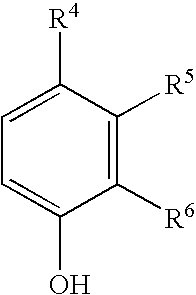Pharmaceutical compositions comprising iron chelators for the treatment of neurodegenerative disorders and some novel iron chelators
a technology of neurodegenerative disorders and pharmaceutical compositions, which is applied in the direction of drug compositions, ester active ingredients, amine active ingredients, etc., can solve the problems of neuronal death, cell death, cell death, lipid peroxidation of cell membranes,
- Summary
- Abstract
- Description
- Claims
- Application Information
AI Technical Summary
Benefits of technology
Problems solved by technology
Method used
Image
Examples
example 1
Synthesis of N-[2-(4-carbobenzoxypiperazin-1-yl)ethyl]-4,5-bis[bis(benzyloxycarbonylmethyl)amino]valeramide (1)
To a solution containing N-[2-(4-carbobenzoxypiperazin-1-yl(ethyl]-5-diaminovaleramide (100 mg, 0.27 mmol) in 1 ml CH3CN (freshly distilled over P2O5) a mixture of tetramethylnaphthalene-1,8-diamine (0.306 g, 1.43 mmol) and NaI (0.021 g, 0.14 mmol) in 0.12 m n freshly distilled CH3CN was added. The mixture was heated slightly and stirred under a nitrogen atmosphere to dissolve all components, benzyl 2-bromoacetate was added thereto (0.22 ml, 0.328 g, 1.43 mmol), and the mixture was refluxed at 96° C. for 22 h under a nitrogen atmosphere.
Subsequently, the precipitate was filtered off and the solvent evaporated. CHCl3 was then added to the filtrate, the solid filtered off once again, and the solvent evaporated.
To remove excess benzyl bromoacetate, the residual oil was then washed a few times with hexane, and finally dried under vacuum to yield 300 mg crude product. The produc...
example 2
Synthesis of N-(3-benzyloxycarbonylaminopropyl)-4,5-bis[bis(3-acetyl-4-hydroxybenzyl)amino]valeramide (2)
A suspension of 2-acetyl-4-chloromethylphenol (0.48 g; 2.6 mmol), N-(3-benzyloxycarbonylaminopropyl)-4,5-diamino-valeramide (0.14 g; 0.43 mmol), diisopropyl(ethyl)amine (0.47 ml; 2.96 mmol) in DMF (10 ml) was stirred at room temperature for 24 h. The mixture was evaporated to dryness. CHCl3 (80 ml) was added to the residue, the reaction mixture was filtered off and the solvent was evaporated. The oil was purified by flash chromatography on silica gel using 1% MeOH / CHCl3 as the eluent to receive the pure title product (0.152 mg; 38%). TLC (2% MeOH / CHCl3), Rf=0.22.
example 3
Synthesis of N-(3-benzyloxycarbonylaminopropyl)-4,5-bis[bis(3-(1-hydroxy-iminoethyl)-4-hydroxybenzyl)amino]valeramide (3)
A suspension of Compound 2 of Example 2 (0.55 g; 0.06 mmol), NH2OH.HCl (0.042 g; 0.6 mmol) and NaHCO3 (0.055 g; 0.065 mmol) in MeOH (15 ml) was stirred at 65° C. for 48 h. CHCl3 (50 ml) was added to the reaction mixture. The precipitate was filtered off, the solvent was evaporated, and the residue was purified by flash chromatography on silica gel using CHCl3 and 5% MeOH / CHCl3 as the eluents. 12 mg (20%) of the title product was eluted with 10% MeOH / CHCl3. The product is not soluble in CHCl3. TLC (10% MeOH / CHCl3). Rf=0.15.
PUM
| Property | Measurement | Unit |
|---|---|---|
| Molality | aaaaa | aaaaa |
| Molality | aaaaa | aaaaa |
| Molality | aaaaa | aaaaa |
Abstract
Description
Claims
Application Information
 Login to View More
Login to View More - R&D
- Intellectual Property
- Life Sciences
- Materials
- Tech Scout
- Unparalleled Data Quality
- Higher Quality Content
- 60% Fewer Hallucinations
Browse by: Latest US Patents, China's latest patents, Technical Efficacy Thesaurus, Application Domain, Technology Topic, Popular Technical Reports.
© 2025 PatSnap. All rights reserved.Legal|Privacy policy|Modern Slavery Act Transparency Statement|Sitemap|About US| Contact US: help@patsnap.com



